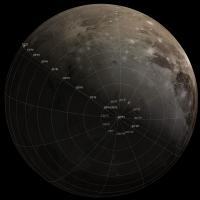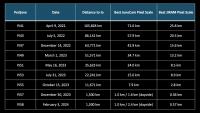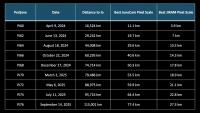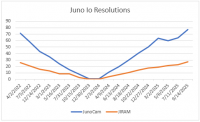Printable Version of Topic
Click here to view this topic in its original format
Unmanned Spaceflight.com _ Juno _ Juno- Satellite Observations
Posted by: Ken Arromdee Jun 16 2016, 07:23 PM
I know this mission is not meant to study any Jovian satellites, but is Juno going to, by chance, pass near enough to any satellites (particularly small, not well imaged satellites) that it could take any useful pictures of them? (Or will it be possible to finagle the final de-orbit burn to send it past a satellite for this purpose?)
Posted by: centsworth_II Jun 16 2016, 07:39 PM
At the press briefing it was stated that although Juno will not get close to Jupiter's moons it will be taking pictures and because of it's polar orbit will get never before seen looks at the moons.
Posted by: Gerald Jun 16 2016, 08:37 PM
In the Planetary Radio talk I've referenced, Candy Hansen mentioned, that Juno is planned to get close to one of the Ring moons. But since those moons are tiny, the moon is expected to show up as a small spot only.
--- Might be, that positional data of the moon can be refined this way.
[I'd think, this thread should better be merged to the Jupiter approach thread.]
Posted by: Glenn Orton Jun 17 2016, 01:03 AM
We may get some observations of satellites, but it's not the focus of the mission, and anything we obtain will probably not rival anything obtained by a previous mission regarding spatial resolution. I think the Juno engineers will consider 'finagling' a very low priority compared to making a successful plunge into the atmosphere to protect Europa from encounters with the Juno spacecraft. Our opportunities to get any observations of satellites is limited by our polar orbits, as has been noted already. In fact, our best continuous images of the Galilean satellites may be taking place right now with what we call the Approach Movie. This will be released on July 4.
Posted by: nprev Jun 17 2016, 05:47 AM
MOD NOTE: Edited topic title to make it a generic thread for Jovian satellite observations by Juno. Since there aren't likely to be very many, this may suffice for the mission. However, if subtopics are required we'll split them off as needed.
Posted by: Steve G Jul 23 2020, 05:15 PM
New images of Ganymede from Juno.
https://www.nasa.gov/feature/jpl/nasa-juno-takes-first-images-of-jovian-moon-ganymedes-north-pole
Posted by: volcanopele Jul 24 2020, 05:16 PM
Decided to start a new topic [I see there was already a topic from four years ago so I'm merging the two] for the discussion of Juno observations of the Galilean satellites, mostly because many of the best observations are by JIRAM and data from that instrument takes a few months to a year to show up in the PDS. There have been observations of moons via JunoCAM at lower resolution that have been useful, like observations of the Chalybes plume at Io.
The other day, the JIRAM team had a press release showing off their observations of Ganymede from PJ24:
https://photojournal.jpl.nasa.gov/catalog/PIA23988
They don't say in the caption but I presume that the blue and green channels use L band data (3.455 µm) and the red channel uses M band imaging (4.78 µm). Let's take a look at the M band data since there are more surface feature contrast:
at first glance that doesn't really look much like Ganymede does it? What if we do a quick invert of the brightness values?
Okay, now it is starting to look like the Ganymede we know. The bright regions in the original image are the dark "Regios" (specifically, the one of the right in each image is Perrine Regio). The dark spots in the original image are bright at visible wavelengths and are the icy ray of relatively fresh impact craters. This invert method works because water ice absorbs light at 4.78 microns, so ice rich areas are dark while comparatively ice-poor regions are bright. So inverting the 4.78 micron images gives something that better resembles visible light images.
For a comparison, here is a Cosmographia preview of the middle image:
Posted by: JRehling Jul 26 2020, 01:00 AM
That's a cool demonstration, Jason. If you wanted to take it one step further, another factor determining luminance across the image is the phase angle, so if you divided those by images of lambertian spheres at the same phase, you'd get a closer match to the local albedo. (Mainly, the terminator would not seem excessively bright.)
Posted by: Antdoghalo Jul 26 2020, 07:30 PM
Unfortunately it didn't hit the small unmapped region near the north pole on the other hemisphere. It is nice to see Juno can image the Galileans with detail. Even if low resolution, any imagery of that area would be suitable to fill in the roughly 3 percent of Ganymede Galileo missed. Juno's orbit is adequate to imaging the unmapped areas around the poles.
Posted by: Decepticon Jul 27 2020, 07:06 AM
Any more future bonus moon images?
Posted by: volcanopele Jan 21 2021, 10:35 PM
Finally got around to adding a Juno section to my small webpage of Io images:
https://pirlwww.lpl.arizona.edu/~perry/Juno/
Mostly consists of JIRAM data though there are a few JunoCAM images thrown in. Tried to maintain a standard format of the summed JIRAM image on the left and a gradient map version overlaid on an Io basemap on the right. Images are magnified 10x from the original data.
For PJ57 and 58, there are some sample JunoCAM preview images, though keep in mind that JunoCAM will not get all those images due to data volume considerations and other constraints.
Posted by: volcanopele Feb 8 2023, 03:35 PM
Updated the above page to include images from PJs 40, 41, 43, and 47. Sorry that took a bit longer than expected.
https://pirlwww.lpl.arizona.edu/~perry/Juno/
Posted by: volcanopele Jul 24 2023, 11:41 PM
Another update to my Juno image page, now with JunoCam images from PJ51 and JIRAM data from PJ47. I also updated the hotspot map.
https://pirlwww.lpl.arizona.edu/~perry/Juno/index.html
Posted by: Antdoghalo Jul 31 2023, 04:36 PM
Do you plan to map the Juno images too?
Posted by: volcanopele Jul 31 2023, 05:12 PM
I do have JunoCam maps in Arc Pro. Maybe I'll release a few with PJ53.
Posted by: Antdoghalo Jul 31 2023, 05:38 PM
That would be awesome because from here on, the Juno passes will improve on older maps especially at the poles with the next 2 passes. If you can, try to map previous passes too, I think PJ51 improved on mapping.
Posted by: volcanopele Sep 20 2023, 09:04 PM
Another update to my Juno image page, now with JunoCam images from PJ53.
https://pirlwww.lpl.arizona.edu/~perry/Juno/index.html
For PJ53, I included a simple cylindrical projection product.
Posted by: Antdoghalo Sep 20 2023, 09:09 PM
Neat! BTW when will you post on the Gish Bar Times again? Io's finally getting some love from Juno
Posted by: volcanopele Sep 20 2023, 09:19 PM
Maybe that's coming soon? I have a few ideas previewing the encounters. Have to be a little careful, as back in the good ole days of the blog, I could write about whatever I wanted as my work/research tasks didn't overlap. Nowadays though I do some work related to JIRAM in particular, and JunoCam as well. So I do need to be a bit careful scooping myself.
Posted by: Antdoghalo Oct 11 2023, 12:02 PM
I have a question about post Io operations should Juno manage it. Could Juno eventually be able to flyby and image Amalthea further down the road and accomplish what Galileo was not able to?
Posted by: xflare Oct 11 2023, 01:01 PM
Are the "image times" at https://pirlwww.lpl.arizona.edu/~perry/Juno/pj55.htm in UTC?? Trying to find times of closest approach
Posted by: Explorer1 Oct 11 2023, 01:41 PM
Amalthea is tiny and Junocam's FOV is very large; a flyby would have to be very close to improve on Galileo, so I wouldn't hold out too much hope...
Posted by: volcanopele Oct 11 2023, 04:05 PM
Yes, those times are in UTC. Please note that these are just examples. I don't know the JunoCam team's actual image plans and so I just took the PJ53 image times, used that as a template around the C/A time and adjusted them based on when the green filter was centered on Io (from the predict c-kernel).
C/A time for PJ55 is 10/15/2023 06:47:21.316
Posted by: volcanopele Nov 16 2023, 06:19 PM
The reference trajectory for Juno has been updated (spk_ref_231110_251016_231110.bsp). This includes the updated Io encounters in 2024 and 2025 that Scott Bolton mentioned at OPAG back in May, though some of the distances have been adjusted since that presentation. Here is that update. First table has the encounters through PJ58 which are unchanged, and then the post-PJ58 encounters.
Posted by: StargazeInWonder Nov 17 2023, 03:51 PM
I did a little math on the possibility of a worthwhile Amalthea image – for favorable geometry to occur by happenstance without planning for it is rather unlikely, even if Juno's orbit eventually spends a few orbits intersecting the equatorial plane of Jupiter near the semimajor axis of Amalthea's orbit. I wonder if there's been any checking of the possibility.
Posted by: vjkane Nov 17 2023, 07:37 PM
I plotted out the resolutions in the tables that volcanopele posted versus date.
I looks like the mission will tweak the orbits in 2025 to keep 3 encounters at nearly the same resolution. I wonder if the geometry of the imaging/lighting is particularly favorable then.
Powered by Invision Power Board (http://www.invisionboard.com)
© Invision Power Services (http://www.invisionpower.com)




